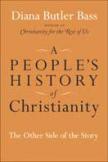A More Humble Reading
Diana Butler Bass is probably not as much a household name in most Roman Catholic circles as she is in mainline Protestant ones. She was raised as a Methodist in Maryland and later found a spiritual home in the Episcopal Church. Butler Bass is not just an author and guest lecturer; she is an entire cottage industry. She is perhaps most noted for her previous books, Christianity for the Rest of Us: How the Neighboring Church Is Transforming the Faith and Strength for the Journey: A Pilgrimage of Faith in Community, among others. In addition to writing, Butler Bass is a researcher and guest speaker at many parishes, seminaries and national church organizations. Theologically trained as a church historian, she taught at Westmont College, the University of California at Santa Barbara, Macalester College, Rhodes College and Virginia Theological Seminary. For the past several years, however, she has been touring the United States engaged in research that I like to call “best practices for Christians,” investigating what works and what does not in the local faith community. I usually do not consider church history to be stimulating; bad memories from seminary still haunt me, trying to keep homoousios and homoiousios separate in my mind was no easy task. Much of church history involves reading about the development of doctrine (that is, ideas), but quite often the people behind those ideas or their social fabric get lost in the process.
As Butler Bass herself says in the book’s introduction, “This history is less a magisterial narrative and more like a collection of campfire tales—discrete stories that embody Christian character, virtue, suffering and commitment as people, ‘go and do likewise’.” Friends swapping stories, as it were. What Butler Bass has done with church history, the Byzantine and Lutheran liturgical experts Robert Taft, S.J., and Frank Senn have done for liturgical studies in their books, Through Their Own Eyes: Liturgy as the Byzantines Saw It and The People’s Work: A Social History of the Liturgy.
This is exactly what A People’s History of Christianity: The Other Side of the Story is all about: the “other side” of what I learned in seminary, the inspiring and encouraging everyday stories of Christians who have long been forgotten. The book is divided into five parts and is organized chronologically: The Way (Early Christianity); The Cathedral (Medieval); The Word (Reformation); The Quest (Modern Christianity) and The River (Contemporary Christianity). Each part is then divided into three chapters, within which are numerous sub-sections on reading Scripture, honoring the body, peacemaking, neighbors, ethics, freedom and prayer, among other things.
Known for her previous books on Christian practices, the rites and rituals or smells and bells, Butler Bass opens a whole new door to mainstream American Christianity by explaining the importance of the ancient prayer of the hours, the theology and function of the grand cathedrals of Europe, the use of icons as well as the importance of teaching and catechesis. The author’s prose is uplifting and positive. Her style is conversational, allowing one to feel she is speaking directly to the reader, not to students in a college lecture hall. This feeling is enhanced by some personal vignettes she has sprinkled throughout the book.
The book, however, is more than a series of fireside chats of bygone days, of kings, popes, saints and sinners. The author views the contemporary renewal of the church through the lens of social history. As with her book Christianity for the Rest of Us, Butler Bass is interested in finding areas of renewal in the church. In other words, in the contemporary church—and here she means mainline Protestant, although one could add the Anglo-Catholic as well—what stories can we find that offer inspiration, encouragement and nourishment for the soul? How can we be creative by looking at both the big “T” Tradition (faith and doctrine) as well as the small “t” traditions (rites, rituals and devotions)? Who are the inspiring people and their stories in our common Christian past that may help guide and lead us in the 21st century?
It is easy to look around at the big C church and see everything that is wrong with it: lack of financial resources, administrators who more often than not are ill suited for their respective leadership positions, the lack of interest in parish life by the laity. The list could go on. Yet reading A People’s History of Christianity left me with a sense of hope—despite countless scandals, heresies and wrongdoings, usually by administrators and leaders. My hope is that the church continues to move forward in maintaining the basics of the faith, in the spirit of St. Benedict, who taught that the Christian life is both laborare et orare, work and prayer.
This article also appeared in print, under the headline “A More Humble Reading,” in the August 31, 2009, issue.








